Nigel J. Ross
Travelogue


We had a moment of panic when arriving at Malpensa airport to take the plane to Sofia. Although our tickets said departure time at 9:50, at first we couldn't find the Alitalia flight on the screens, but eventually we saw it was scheduled for 9:05 (and we would probably miss it). After a moment of consternation, we then saw that its departure was delayed till 9:50 (relieved, the timings still remain a mystery). After that, the rest of the journey went very smoothly.
We found a semi-official taxi at a reasonable rate to take us from Sofia airport to the Lion Hotel in Sofia. Although not cheap, the hotel had just been nicely refurbished and was well located at the top of Maria Luisa boulevard, near the lion bridge. Carla was exhausted and had a lie down in the afternoon, and I went for a walk around. It was a short walk into the centre, and I soon spotted the central renovated Banya Bashi mosque. The square behind it was a pleasant place for a sit down, a look at the guidebooks and an opportunity to think about what to do in the centre for a couple of hours. At the opposite side of the square is a fascinating old building, formerly the steam baths, and now being renovated to house a future museum of the city. On the far side of the square is the interesting Halite old market hall, now turned into a modern indoor market with small shops selling food and so on. I treated myself to an ice cream in a pedestrian area nearby, and it turned out to be bigger than I expected, but the two large scoops in a hard cornet were delicious. I walked the length of the pedestrianised Pirotska Street before finishing it!
 Sofia, the former steam baths
Sofia, the former steam baths
Next I headed south, into the area called the Largo, which boasts a massively imposing building at one end, the former Communist party headquarters. The opposite end has an uninspiring statue of a winged woman representing the sophistry (wisdom) of Sofia and replacing the former statue of Lenin. A shop-filled underpass which also leads to an underground station allows you to cross under the central part of the Largo, and in the open-air in the middle of the underpass stands the tiny half-hidden church of Sveta Petka Samadjiska, rather lost among its modern commercial surroundings.
I next went to see the ancient Roman chapel of St. George, much reconstructed and surrounded by tall, soulless buildings. Inside some rather dark partial frescos were very old and interesting. Just a but further south, I came to the square of Sveta Nedelya with its large, squat church. I popped round the corner and stuck my nose into the tiny half-underground chapel of Sveta Petka, busy with locals. A block further east are the city gardens with many open air cafes, the best just in front of the columned facade of the National Theatre. In the gardens there was in interesting open-air exhibition of the rebuilding of the centre of Beirut, which brought back many happy memories of holidays a year earlier.
 Sofia, the Roman church of St. George
Sofia, the Roman church of St. George
I walked back to the square of Sveta Nedelya and went into the church. It is very impressive inside, with a massive richly-decorated iconostasis (screen). A service was on, and so it was interesting to hear the service taking place on the other side of the screen and to watch the orthodox priests coming out from time to time to bless the faithful waiting near the iconoclast. Various other icons here and there in the church were being revered by locals, too. The church is something of an unofficial cathedral, and very busy with locals coming and going, to say a prayer, kiss an icon, light a candle or sit for a while in the cool interior.
I slowly walked back to the hotel, stopping to buy some tram tickets for the evening (not without difficulty as the lady in the ticket kiosk spoke no English, but I'd worked out how to say "four" (chetiri) and "tickets" (bileta) beforehand, and miraculously I got what I wanted. An hour later, we caught the tram, and after being shouted at by the lady driver for pushing the request button too many times, we got off the tram and found the Dream House vegetarian restaurant we'd decided to seek out, where we had a good meal. The stuffed fried mushrooms were delicious, and the bill came to around Euro 4 for the two of us! A first pleasant surprise that was to be repeated every time we got a restaurant bill. We walked back to the hotel, but attempts to get a hot drink on the way back were thwarted by the fact that most bars were closing at 10 o'clock!
We spent the whole of the next day in Sofia. We first walked the length of the colourful "Ladies Market" which starts in a street next to the Lion Hotel and leads almost into the centre. Most of the rest of the morning was spent looking at the "sights" I'd already seen on my own the day before, but most were well worth a second look. We had a drink and a bite to eat in an open-air cafe in the City Park and then walked to the cathedral proper of Aleksander Nevski. The cathedral is a vast pile of mushrooming domes, the top ones gilded with glittering gold leaf. We approached the cathedral slowly, being lured by the many bric-a-brac stalls lining the route to the main doors. The inside was not so inspiring, the fairly modern frescos being sombre even if ornate.

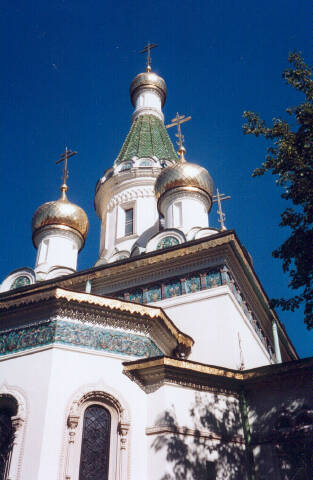 Cathedral and Russian church
Cathedral and Russian church
We looked at the nearby attractive Russian Church and strolled around the Ethnographic Museum - and interesting collection of costumes and other traditional items of folk life - housed in the former Tsar's palace in all its fading glory. We wandered back to the hotel via the Sveta Nedelya church, which is perhaps the most inspiring in Sofia, and it also allowed us a cool rest. Back to the hotel for a spruce up, but then we had problems finding our chosen restaurant for dinner. After much searching, time wasting, trips in taxis and long marches, we realised that there was a small street and a large boulevard with the same name, and while the restaurant was in the small street, we were always being sent or taken to the large boulevard. And when we eventually found the place it was closing … however, by a stroke of luck we found another place nearby and had a reasonably good, quick meal before a walk back to the hotel (and a good night's sleep after such an exhausting evening).
We got ourselves going quite quickly from the Lion Hotel the next morning, and walked to the snazzy new glass-fronted bus station. We caught the 10:30 coach to Blagoevgrad, a couple of hours due south of Sofia. It was an easy journey along a newly upgraded road (paid for out of EU funds). At the Blagoevgrad bus station we hopped into a taxi and went across town to the Hotel Kristos standing on a hillside overlooking an old church and cloisters. After checking in, we walked into the modern town centre, bought a bread roll, and then caught a taxi back to the bus station to go to Rila village, where after a short wait we caught another bus for the last 20 km along a narrow green valley into the hills where Rila monastery is hidden. In a beautiful natural setting, Rila monastery is the jewel in the crown of Bulgaria's wealth of orthodox monasteries. A UNESCO World Heritage site, it looks very uninspiring from outside ... just tall long fortress-like walls. But as soon as you step into the vast irregular, almost triangular-shaped courtyard, it is a very different picture. The outer walls were ringed inside by several wooden stories of cells and rooms, all with open wooden landings, stairways and balconies.

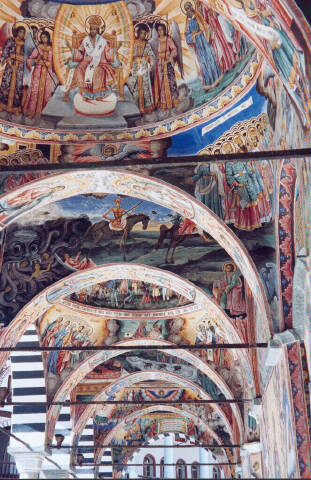 Rila monastery
Rila monastery
The overriding picture was one of ramshackled wooden structures against black-and-white stuccoed walls all surrounding an extremely attractive central church. The church itself repeated the same black-and-white (and red) striped patterns, but the portico revealed some almost garishly-coloured frescos, and the domes perched on top completed the amazing scene. Inside the church, there was a wealth of frescos, many spiritually-important relics and an incredibly ornate iconostasis. It was an excellent visit, and a pleasant trip back through the rich countryside - a deep green valley, then vineyards, orchards and extensive fields of sunflowers - back to Blagoevgrad. We had a meal on the terrace of the Hotel Kristos (not without problems due to mosquitoes and an uncooperative waiter) and a walk through the very lively well-kept town centre before another well-deserved rest.
Earlyish again the next morning we were again back at Blagoevgrad's bus station to get a Sandanski, an hour and a half further south. We had an hour between buses in Sandanski and walked along the town's main pedestrianised shopping street where we had a coffee at a pavement cafe before catching another bus for a final ¾ hour drive into the hills. We arrived hot and sticky at Melnik (the coach's air conditioning wasn't working and the windows didn't open) around 13:30, and it was a short but hot uphill walk from the bus stop into the main part of the village. We stayed in the basic but clean Rodina Hotel, a little in fear of the lady owner who we nicknamed the "Generalissima". Although she didn't speak a work of English, she certainly made herself understood ... but sometimes gave an occasional smile.
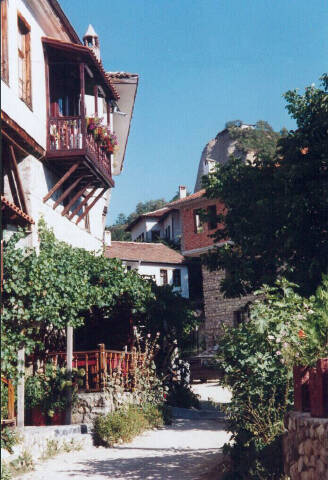 Melnik
Melnik
Melnik is a very quaint mountain village (or small town - it had been a much larger town in earlier times) spread out on either side of a stream. We found ourselves a shady cafe terrace for a late, lazy lunch, and then spent a little time exploring the place. Apart from its charming setting, nestling under tall mountains, the village has a fairly traditional rural appearance, with all houses having stone lower floors, timber and whitewashed upper floors and red tiled roofs. Truly picturesque. Some of the town is ruined (especially the Bolyasha Kashta, a large mansion house, the church of Santa Barbara and the old Turkish baths), but much is very well kept. We had dinner on a vine-covered terrace of a restaurant perched on a rocky outcrop above the town, and had a delicious meal washed down with a glass of the famous smooth, sweet, titillating local red Melnik wine.
We had problems next morning with the Generalissima, and somehow managed only to get a cup of coffee for breakfast (we should have prepared a few words in Bulgarian beforehand). But as we needed to be off fairly quickly, we left her to tend to other guests. With our backpacks full of water and fruit, we set off to walk 6 ½ kilometres over the mountains to the next valley. With help from the instructions in the guidebooks and little piles of stones that earlier walkers had left, we first walked up the bed of a dried-up river torrent. The vegetation was interesting with lots of pine trees, but also lots of wild flowers. We managed to mislead a couple of French girls at one stage - they thought we looked as if we knew where we were going, and instead we'd taken a wrong turning. But without many other hitches, we soon found the path that began the ascent of the valley side. And it was quite a steep climb. We were glad we'd set off reasonably early, before it was getting too hot. We soon were out of the trees, and there was no shade among the scrubby bushes. We soon got good views of Melnik in the valley floor, but also of the strange rock formations along the crests of the mountains in the Melnik area. After about ¾ hour we got to the top of the crest and marvelled at the series of stone-capped pinnacles on either side of us. And then we began the descent into the next valley along a rather scary narrow path with a sheer drop on one side. But we made it, and before long we were walking through an "Alpine" meadow towards the monastery of Rozen below us in the valley.
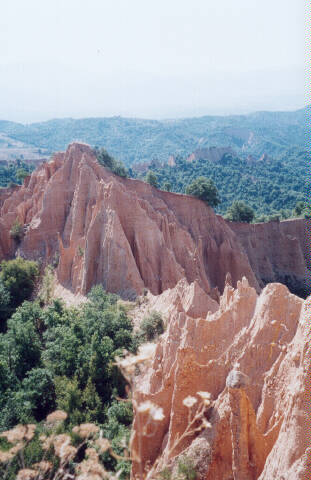
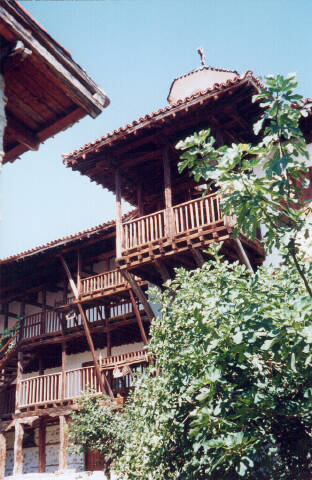 Rock formations and Rosen monastery
Rock formations and Rosen monastery
Like Rila, the outside of the monastery was austere and unadorned, but the interior was a revelation. Though much smaller and less ornate than the magnificent Rila monastery, Rozen monastery is humbler, but somehow more spiritual. It has the same triangular-shaped pattern, with just one area of elaborate wooden staircases and landings. On the upper floors of Rozen we had the opportunity to look into some of the old kitchens and refectory, all very simply and plain. The church itself was a different matter. The small portico had a wonderful (though rather gory) fresco of the last judgement, and the interior had many excellent frescos and an outstanding iconostasis.
We sat in the courtyard for a while, taking in some of the peacefulness the place exuded. We couldn't stay too long, however, as we had to catch one of the few buses back to Melnik at 12:50. Back in Melnik, a latish salad lunch on a shady terrace gave us the energy to walk uphill to the Kordopulov House. Well-restored, the house belonged to a local nobleman, and is now open to the public. Its airy salons, with a mixture of Ottoman and European styles, and its lovely stained-glass windows made it a very attractive interior. The cool basement was originally used for making and storing the local Melnik wine, and a free taste was available for visitors. We also explored the maze of cold long tunnels cut into the rock led directly from the vineyards into the cellars. Walking back into the village from the Kordopulov House, we looked round the local museum, and then I climbed the escarpment to the south of the village and walked along the ridge east and west, to the remains of an old fort at one end, and an old church at the other. The views in the warm late-afternoon sunlight compensated for the steep climb. And everywhere in Melnik there seemed to be so many wild flowers and wild fruit (we picked wild yellow and red plums, greengages, blackberries, apples and almonds). We had another good meal that evening, and Carla bought a local carpet (though would have preferred to buy the cuddly little month-old kitten that was playing in among the carpets on sale in the shop!).
We were up before 7 o'clock the next morning, and having prepared our Bulgarian spiel got the Generalissima's husband (a huge but more amenable creature) to give us a decent breakfast. We were at the bus stop by 8 o'clock for the bus (as instructed by the locals) ... except that it only came at 9 o'clock! We had another hour between buses in Sandanski and repeated our walk along the main street and coffee at a street cafe, and were back at Sofia bus station at 14:30 (we had plenty of fruit we'd gathered in Melnik to eat on our journey). We then caught the 15:00 bus to Plovdiv, Bulgaria's second city, in the heart of the country. Although the coach was a modern two-decker affair, the air conditioning was again not working and it was an unpleasant 2 ½ hour sauna to Plovdiv. We had problems finding a hotel in the city, the more reasonable one we first went to having only tiny, noisy rooms. We eventually got a special weekend rate in the top hotel in the city, the Hotel Trimontium Princess, and treated ourselves to a night of luxury after the Generalissima and her husband. We were exhausted after a long day of travelling, made worse by the heat of the last stage and the weary search for a hotel in Plovdiv, so we just went to a quite good restaurant in the same square as the Trimontium Princess and had a quick meander along the main boulevard before a very comfortable night's sleep.
We awoke to another sunny day - the weather had been kind to us all the time, even in the mountains, though it tended to get a little cool in the evenings in most places, even in Sofia which is at an altitude of 500 metres (Europe's highest capital city) - but after breakfast it was clouding over, though still warm and humid. We asked at the reception desk about trains to the coast for the late afternoon, and left our luggage so that we could spend the morning and early afternoon exploring old Plovdiv. Walking from our hotel along the main pedestrianised shopping street, we soon got to the sunken remains of an old Roman stadium and the old city mosque next door. The low interior of the mosque was decorated in an unusual light blue. A fellow came and explained much of the history of the place, but expected a donation (and when we put money in the box rather than into his hand, he was not pleased). The mosque was at the start of an area of steep cobbled streets forming the old part of the town. The many historic buildings, the antique shops, the old churches, the cafes, the ruins of the old citadel and the town walls make for a picturesque little centre. We peeked in on a tiny jewel of a church, Saints Konstantin and Elena. Although its iconostasis was not covered in gold leaf, it was intricately carved in walnut wood, almost making it more attractive than some of the glitteringly shiny ones we'd seen elsewhere. We had lunch at a little outdoor cafe near the citadel, but heard many rumblings of thunder in the distance.
 Plovdiv, interior of mosque
Plovdiv, interior of mosque
After lunch we visited the Ethnographic Museum housed in a delightful wooden house with superb panelled and carved ceilings. The building itself in a enchanting small garden was at least as interesting as the items on display. We walked back to the hotel via the vast Roman amphitheatre, and got to the train station still in fine weather, despite the black clouds and continuing rumbles of thunder. The train was a bit grubby, but comfortable, and we sat down for a four-hour journey to Burgas on the coast. Unfortunately the information we'd been given had not been very precise. Instead of the 4 o'clock train being a four-hour express train, it was only a "fast" train (ie. stopping train) that would take over 5 ½ hours to make the journey. In addition, the storm broke shortly after we left Plovdiv, and the rain lashed down, it hailed and there was frighteningly-close thunder and lightning. The window in our compartment had a nasty habit of dropping open every so often, and so we had to be prepared to shut it quickly or be totally drenched! At one stage there was severe flooding, and the tracks were under water. The slow journey became slower, but the train kept on going (slowly but miraculously), and we eventually got to Burgas (in light rain) just after 10 o'clock. We took a taxi to the nearby Primorets Hotel that looked like something out a 1950s Communist film set, but we hardly felt like searching around for alternative places so late in the evening. Luckily there was a nearby 24.hour restaurant where we managed to get a reasonable meal at 11 pm!
We awoke to sunny views over the Black Sea, though we saw more of the port than the beach from our hotel balcony. After breakfast, we took a quick circular tour round the centre of the city of Burgas. We walked through the marine park, along a stretch of the untidy beach and then through the centre. The small old Armenian church was disappointingly bare inside, and the main square with its statue of an unknown Russian soldier was not particularly attractive. After a coffee, we collected our luggage and walked to the bus station to get the 12:30 bus to nearby Sozopol. Almost a week exactly after arriving in Bulgaria, we arrived at the little Black Sea resort of Sozopol, which we made our base for five days. We found a nice top-floor suite at the Alfa-Vita hotel - a spacious bedroom and sitting room, a large terrace and convenient bathroom, all for Euro 27 a day. If the staff had been a bit more friendly, it would have been an ideal place. At last we could unpack properly, and also do some washing - there was a very useful washing line (with pegs) on the terrace!
 Sozopol
Sozopol
In the afternoon we explored the new town of Sozopol (Harmanite), a busy area with lots of shops and higgledy-piggledy residential development leading down to the southern beach. We stretched out on the beach for an hour, and paddled in the sea, though it was a bit choppy and the red flags were up, so we didn't have a swim. In the evening we wandered into the old town, hoping to find a restaurant near the port. However, either things have changed or the guidebook got it wrong, but there is only one decent place to eat in the port, and it was full (and also had extremely loud music). Looking for somewhere else, all of a sudden we felt a spot of rain and before too long it was pouring down. Despite having a foldable umbrella, we got soaked, but eventually found a sheltered open-air restaurant where we could dry off and have something to eat. By the time we'd finished, it had stopped raining, and everywhere had just about dried up!
The next day, Tuesday, the sun was out again, and it was warm - in fact although it did rain on a few occasions while we were in Bulgaria, it nearly always and very obligingly rained overnight or when we were travelling. It was time for a lazy day looking round Sozopol, doing a bit of sunbathing, and generally taking things easy after a very intense first week in the country. The old town is full of quaint old timber houses on a rocky headland, offering stunning views out to sea and the islands nearby. It was a good day to wander around, have a lazy salad lunch on a shady terrace, write a few postcards, browse around the market, climb to a vantage point for views of the headland, and have an ice cream. The terrace where we had our dinner that night on the headland was breezy, but the seafood was excellent, and when you can get an excellent fish meal with a glass of wine for around Euro 5 a head or less, the pleasure is double!
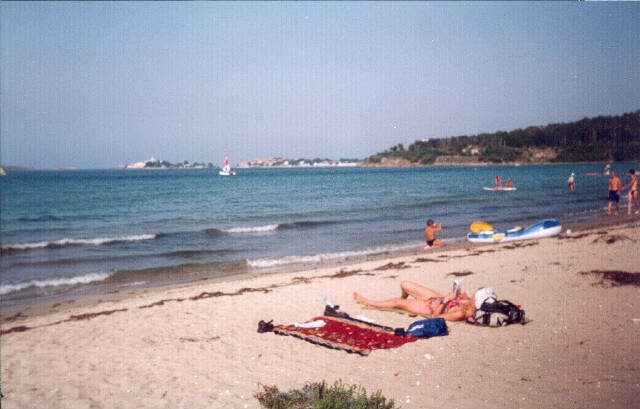 Sozopol beach
Sozopol beach
After getting embroiled in a TV movie in the morning and doing some chores, in the afternoon of the following day we took a bus to the nearby town of Kiten, ¾ hour south of Sozopol. Kiten is a more spacious, relaxed place than Sozopol, but all rather tacky and modern. The long, wide beach, however, was more attractive and less busy, and we enjoyed spending a couple of hours lying out on the soft sands. The bus back to Sozopol took a different route than going, hugging the coast and taking us past some very attractive undeveloped stretches of coastline. Back in Sozopol, we showered and walked to the tip of the headland for a meal in the Panorama restaurant, one of the best meals we had. Starters were tiny, tasty marinaded fish, a mixed cabbage salad and a cold mashed aubergine salad; seconds were a fresh local fish, and with a mineral water and a glass of beer, the bill came to a total of just over Euro 7 for both of us! We wandered back through the old town, and somehow found room for a fig-jam pancake.
The following day we took a bus to Burgas and then from there another bus to the town of Nesebar. Famed as the most beautiful spot on the Black Sea coast, it is a little too close to the mega resort of Sunny Beach, and therefore crowded with tourists. It is certainly a picturesque spot with its fascinating old churches with glazed terracotta decorations, its ruined cathedral, its timber houses, its rocky peninsula position, its old town walls and so on, but the throngs of tourists and the shops of souvenirs tend to spoil the place a little. We particularly enjoyed visiting the church of St. John the Baptist, now housing an art gallery, but the highlight was the church of St Stefan, now a museum. Outside, the smallish church is only fairly plain, but the interior has some remarkable old frescos, beautiful icons and an antiquated bishop's throne. The Pankrator church set in well-kept gardens was also very photogenic. We had a light lunch on a panoramic terrace, lay on a tiny beach made entirely of crushed mussel shells for half an hour, had a drink in a converted boat, and generally enjoyed Nesebar when we could avoid the crowds. We had a good bus connection back in Burgas and as we arrived back we fortunately noticed that the old town of Sozopol was in darkness and so headed for the new town for dinner. Our menu that night was a seafood salad, a parsley and bulgur wheat salad, a mackered cooked in sauce, water and wine, all coming to a total bill of Euro 8.
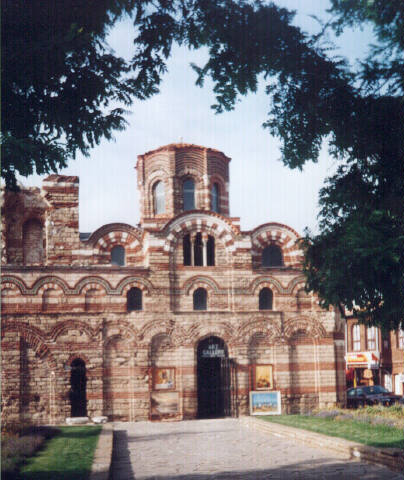 Nesbar
Nesbar
Friday, our last day in Sozopol, was a relaxing day before a heavy schedule of travelling the next day. We walked a couple of kilometres north along the coast past a couple of tiny bays, to a large sweeping bay with a broad stretch of sand. We set ourselves down, at first looking out to a Bulgarian navy ship that was visiting the bay. We ate a delicious cheese pastry we'd brought for lunch, and then spent a lazy afternoon lying on the beach, swimming in the sea, and generally relaxing. Or rather I relaxed while Carla went for an hour's windsurfing, though she chose the day with the least wind, unfortunately! Our last meal in Sozopol was in a delightful restaurant on the old town headland, but while the food was good, the wind picked up shortly after we'd ordered, and we had to hang on to the tablecloth (and our plates) for most of the meal. Back in the town, the wind was not so strong, and we could look round the market stalls for a last time, visit an Internet cafe, look around a few shops and treat ourselves to an ice cream. Although it remained windy, it was still a pleasant evening, but during the night we were awakened by tremendous thunderclaps and heavy rain.
The next day was a bit cloudy, but as planned another day of travelling. Having got well installed in our Sozopol room, it took us a while to get packed up. We eventually got the 11:30 bus from Sozopol to Burgas, but heavy traffic (it was the weekend when Bulgarians were returning home from their August holidays) made it a long journey into the city. We then got the 14:00 bus from Burgas up the coast to Varna. Although not a separated by a great distance, the rugged coast made for a twisty journey up and down promontories and ridges, at times veering inland into luxuriant valleys. We arrived at Varna at around 16:40, and more by luck than by anything else got a 17:00 coach to Veliko Tarnovo, our last main place of stay during our tour of Bulgaria. The journey from Varna to Veliko Tarnovo was interesting. At first it was a long steady climb through verdant countryside on a fast motorway. The motorway then gave way to slower, more twisty roads that meandered through forests, reaching highland plateaux often cultivated with sunflowers, vines and fruit trees. We went through towns and villages, but as always it was strange to see so many uncultivated fields. The weather was sunny at times, clouding over occasionally, but we were lucky not to get any rain. After a while we suddenly got views of the deep gorge of the River Yantra that flows through Veliko Tarnovo, and before too long we were dropping down to the town. From the bus station, we got a taxi to the Hotel Comfort in the old part of the town and chose a cosy room on the top floor with wonderful views over the gorge, out to the fortress. We went out for a bite to eat in the nearby Mecha Dupka tavern in a converted wine cellar and walked around the old town a little before going back to the hotel.
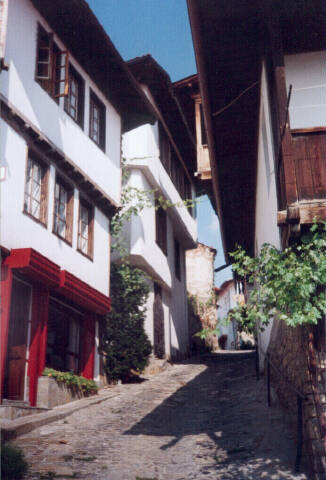 Veliko Tarnovo, typical old street
Veliko Tarnovo, typical old street
We awoke the next morning, Sunday, to overcast skies, but after breakfast the sun was breaking through. We had a coffee in a rather swish cafe, and even coped with a menu all in Cyrillic and with a waitress who spoke hardly any English. The Bulgarians are not naturally helpful or outgoing people, and at first they almost seem stand-offish. However, a few smiles usually help to break the ice, and many people that at first seemed rather off-hand turned out to be kind and helpful. And that was the case with the waitress in the cafe.
The old town, perched on the sides of the gorge, is very picturesque. We stopped to look at the typical old house of the "little monkey", so called because of a strange animalesque statue on the facade. After strolling around the old town, we walked on to the new town, stopping off in a supermarket en route. At the far end of the new town, we looked around the market and then got a minibus to the nearby village of Arbanesi. Along past the fortress and then up a tree-lined valley, the minibus stopped to let us off about ½ mile out of the Arbanesi. But it was a shady, pleasant walk into the village. The village is mainly a series of large traditional houses surrounded by high walls: in the past it was a retreat for the Ottoman rulers, today it is a retreat for Bulgaria's rich and famous. But the village gets a lot of visitors because of one house in particular that is open to the public, the Kostantsaliev House. The upper living quarters have fine salons and an interesting maternity room; the downstairs now houses an expensive gift shop. The small garden gave us a shady spot for a short rest. We walked through the rest of the village, reaching another house that was unfortunately closed to visitors. We'd timed things rather badly and we arrived at the richly-decorated village church just after 6 o'clock, only to find it closed. Back on the main road, we waited and waited for the minibus, but it didn't appear. We then tried to hail an occasional passing taxi, but without success. It was well after 7 o'clock, starting to get a little dark, and we were just reluctantly beginning to walk back the 4 kilometres along the busy, twisty country road, when a taxi did stop and take us back to the town (and the taxi actually cost us less than the price of two minibus tickets!).
That night we had dinner on a restaurant terrace overlooking the Yantra gorge: the fried carp, grilled mackerel, country (mixed) salad and warm potato salad with a glass of beer and a bottle of mineral water came to a total of Euro 7 for the two of us. We were always surprised in restaurants to see that in the menu the description of each dish was accompanied not only by the price, but also by the size in grams of the serving. In fact everything went by weight - when we were served an ice cream it was weighed and we paid according to its weight. We were back in the hotel in time to catch a free view of the son-et-lumière show at the fortress - a spectacular sight from our eagle-nest hotel room.
Our last full day in Veliko Tarnovo started with a look at the old church of St. Nikolai in the old Varosha area of the town, not far from our hotel. It has a very unusual carved, curved balcony and interesting frescos, icons and iconostasis. After slowly wandering down into the lower part of the old town, we tried to get to see the Sarafkina House, but it was almost noon and was closing for lunch. Instead we looked at a scaffold-clad church, the modern cathedral church of Sveta Bogoroditsa with its dramatically severe frescos, and had lunch at a little street cafe near the Museum of the Constituent Assembly (which we didn't visit). After lunch we wandered back to the Sarafkina House and, whether we wanted it or not, got a guided tour by a kind old man who spoke a fast but not clear or fluent English. After his guided tour, we looked around again by ourselves. The old house has a fascinating two-level octagonal hall surrounded by rooms on the lower floor and a balcony on the upper level. The wood panelling and wrought iron work is particularly fine. The house also has some interesting displays of local crafts and traditions. A collection of breads made for special ceremonial occasions was particularly interesting.
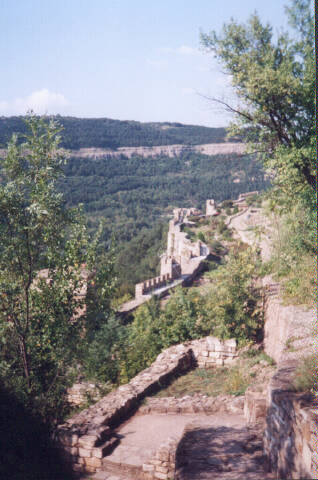 Veliko Tarnovo, the fortress
Veliko Tarnovo, the fortress
After the house museum, we wandered in the direction of the vast fortress (or perhaps "fortified town" is a better description) occupying the Tsarevets hill. Up until the 13th century the walled town housed numerous inhabitants, and had a large royal palace and, pride of place on the summit, a vast patriarchal complex. Unfortunately the visit proved to be a little disappointing. Apart from the walls, very little else remains of the original fortress, and a lot of imagination is needed at times to appreciate what it must have been like. Some sections, on the other hand, have been so heavily restored or rebuilt and look as if they belong in a Disney theme park rather than an archaeological site. We walked along to the northern tip where we looked down to the executioner's rock from which convicts were pushed to their death in the gorge below. The rebuilt central part of the royal palace was not particularly exciting, and the new Patriarchate church on the site of the ancient cathedral is not too unattractive from outside, but downright hideous inside with vicious, angular frescos. We ended the afternoon in the new town, booking the coach for the next day, looking round the shops, and we both bought some jeans, I also bought a pair of shoes and Carla a jacket ... prices are about half what we would pay at home, so it was worth splashing out a bit. We had an excellent meal in an Arabian restaurant near our hotel, and had a very friendly talk with the lady owner and her husband (she's Bulgarian, but speaks English and Italian, while he's Palestinian). We ate the best m'tabal outside (and maybe even including) the Middle East!
We spent our last morning in Veliko Tarnovo in the new town, looking around the shops again - our last opportunity to do any shopping - but without much success. We were particularly interested in buying some typical natural woollen Rhodopa blankets, and the lady in the hotel had even told us the shop to go to - but it was closed all day, and we couldn't find them anywhere else. We got the 15:45 coach to Sofia, and were back in the capital by 20:00. We took a taxi to the Niki Hotel, but were full and only had a suite free. We left our luggage there and wandered round nearby hotels, but realised that the suite at the newly renovated Niki Hotel was the best option, so we ended our holiday in swish accommodation (the suite even had two TVs, one in the lounge and one in the bedroom). We returned to the vegetarian restaurant we'd eaten at the very first night and enjoyed our very reasonably price meal even more so that the first time round, having got a bit wiser to Bulgarian menus. A group of rowdy, ill-mannered English guests came into the restaurant shortly after us, however, and spoilt the meal a little. A last night-time look at the floodlit Sveta Nedelya church and a final Raffy ice-cream completed our last full day in Bulgaria.
We had an hour's walk into the centre of Sofia the next morning, hoping to find the elusive Rhodopa blankets (but without luck). Instead Carla bought a CD, and we bought a couple of cheese pastries to bring back with us. A taxi from the hotel took us to the airport where we spent our last leva on a bottle of Melnik wine, a traditionally-decorated cooking pot and some rose-oil perfume. And then it was back to Milan at the end of a very varied, very intense and very interesting holiday.
Home |
Publications |
Dictionaries |
English Lang. |
Art Insights |
Travel |
Links | ||||||